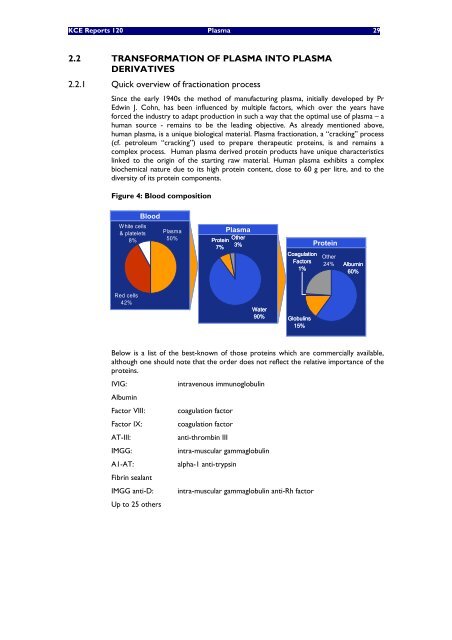The report is available in English with a French summary - KCE
The report is available in English with a French summary - KCE
The report is available in English with a French summary - KCE
Create successful ePaper yourself
Turn your PDF publications into a flip-book with our unique Google optimized e-Paper software.
<strong>KCE</strong> Reports 120 Plasma 29<br />
2.2 TRANSFORMATION OF PLASMA INTO PLASMA<br />
DERIVATIVES<br />
2.2.1 Quick overview of fractionation process<br />
S<strong>in</strong>ce the early 1940s the method of manufactur<strong>in</strong>g plasma, <strong>in</strong>itially developed by Pr<br />
Edw<strong>in</strong> J. Cohn, has been <strong>in</strong>fluenced by multiple factors, which over the years have<br />
forced the <strong>in</strong>dustry to adapt production <strong>in</strong> such a way that the optimal use of plasma – a<br />
human source - rema<strong>in</strong>s to be the lead<strong>in</strong>g objective. As already mentioned above,<br />
human plasma, <strong>is</strong> a unique biological material. Plasma fractionation, a “crack<strong>in</strong>g” process<br />
(cf. petroleum “crack<strong>in</strong>g”) used to prepare therapeutic prote<strong>in</strong>s, <strong>is</strong> and rema<strong>in</strong>s a<br />
complex process. Human plasma derived prote<strong>in</strong> products have unique character<strong>is</strong>tics<br />
l<strong>in</strong>ked to the orig<strong>in</strong> of the start<strong>in</strong>g raw material. Human plasma exhibits a complex<br />
biochemical nature due to its high prote<strong>in</strong> content, close to 60 g per litre, and to the<br />
diversity of its prote<strong>in</strong> components.<br />
Figure 4: Blood composition<br />
White cells<br />
& platelets<br />
8%<br />
Red cells<br />
42%<br />
Blood<br />
Plasma<br />
50%<br />
Plasma<br />
Prote<strong>in</strong><br />
Other<br />
7%<br />
3%<br />
Water<br />
90%<br />
Coagulation<br />
Factors<br />
1% 1%<br />
Globul<strong>in</strong>s<br />
15%<br />
Prote<strong>in</strong><br />
Other<br />
24%<br />
Album<strong>in</strong><br />
60%<br />
Below <strong>is</strong> a l<strong>is</strong>t of the best-known of those prote<strong>in</strong>s which are commercially <strong>available</strong>,<br />
although one should note that the order does not reflect the relative importance of the<br />
prote<strong>in</strong>s.<br />
IVIG:<br />
Album<strong>in</strong><br />
<strong>in</strong>travenous immunoglobul<strong>in</strong><br />
Factor VIII: coagulation factor<br />
Factor IX: coagulation factor<br />
AT-III: anti-thromb<strong>in</strong> III<br />
IMGG: <strong>in</strong>tra-muscular gammaglobul<strong>in</strong><br />
A1-AT: alpha-1 anti-tryps<strong>in</strong><br />
Fibr<strong>in</strong> sealant<br />
IMGG anti-D:<br />
Up to 25 others<br />
<strong>in</strong>tra-muscular gammaglobul<strong>in</strong> anti-Rh factor

















